
Santiago Calatrava Valls is a Spanish architect, structural engineer, sculptor and painter, particularly known for his bridges supported by single leaning pylons, and his railway stations, stadiums, and museums, whose sculptural forms often resemble living organisms. His best-known works include the Olympic Sports Complex of Athens, the Milwaukee Art Museum, the Turning Torso tower in Malmö, Sweden, the World Trade Center Transportation Hub in New York City, the Auditorio de Tenerife in Santa Cruz de Tenerife, the Margaret Hunt Hill Bridge in Dallas, Texas, and his largest project, the City of Arts and Sciences and Opera House in his birthplace, Valencia. His architectural firm has offices in New York City, Doha, and Zürich.

An arch bridge is a bridge with abutments at each end shaped as a curved arch. Arch bridges work by transferring the weight of the bridge and its loads partially into a horizontal thrust restrained by the abutments at either side. A viaduct may be made from a series of arches, although other more economical structures are typically used today.

Eugène Freyssinet was a French structural and civil engineer. He was the major pioneer of prestressed concrete.
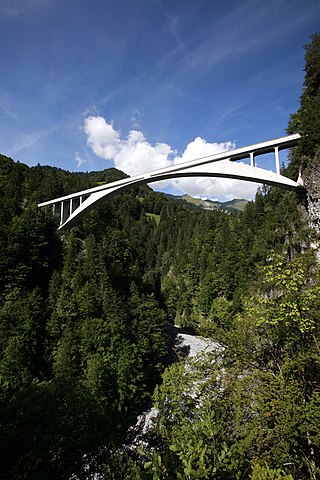
Salginatobel Bridge is a reinforced concrete arch bridge designed by Swiss civil engineer Robert Maillart. It was constructed across an alpine ravine in the grisonian Prättigau, belonging to the municipality of Schiers, in Switzerland between 1929 and 1930. In 1991, it was declared an International Historic Civil Engineering Landmark, the thirteenth such structure and the first concrete bridge so designated.
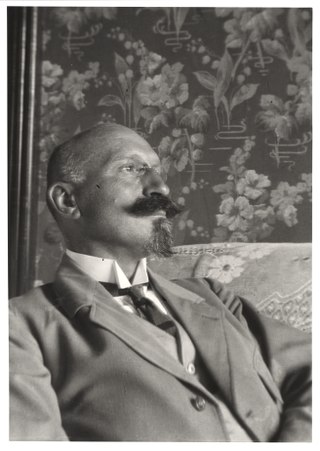
Robert Maillart was a Swiss civil engineer who revolutionized the use of structural reinforced concrete with such designs as the three-hinged arch and the deck-stiffened arch for bridges, and the beamless floor slab and mushroom ceiling for industrial buildings. His Salginatobel (1929–1930) and Schwandbach (1933) bridges changed the aesthetics and engineering of bridge construction dramatically and influenced decades of architects and engineers after him. In 1991 the Salginatobel Bridge was declared an International Historic Civil Engineering Landmark by the American Society of Civil Engineers.
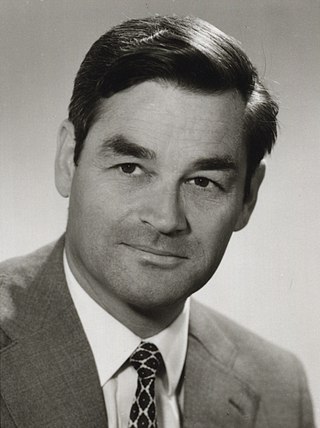
Christian Menn was a renowned Swiss civil engineer and bridge designer. He was involved in the construction of around 100 bridges worldwide, but the focus of his work was in eastern Switzerland, especially in canton Graubünden. He continued the tradition of and had a decisive influence on Swiss bridge building. The technical and aesthetic possibilities of prestressed concrete were most fully realized with his bridges in Switzerland.
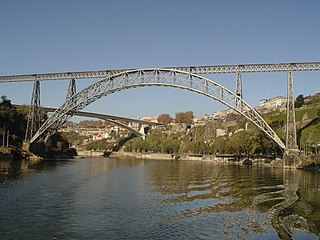
The Maria Pia Bridge is a railway bridge built in 1877, and attributed to Gustave Eiffel, situated over the Portuguese northern municipalities of Porto and Vila Nova de Gaia.

Schiers is a Swiss village in the Prättigau and a municipality in the political district Prättigau/Davos Region in the canton of Graubünden. The first concrete girder bridge ever built, Salginatobel Bridge, is located in Schiers. Designed by Robert Maillart and completed in 1930, in 1991 it was the first concrete bridge to be designated an International Historic Civil Engineering Landmark by the American Society of Civil Engineers.

The Lamar Boulevard Bridge is a historic arch bridge carrying Texas State Highway Loop 343 over Lady Bird Lake in downtown Austin, Texas, United States. The bridge features six open-spandrel concrete arches spanning 659 feet (201 m) and carries tens of thousands of vehicles daily across the lake. Completed in 1942, the Lamar Boulevard Bridge was the second permanent bridge to cross the Colorado River, and one of the last Art Deco-style open-spandrel concrete arch bridges built in Texas. The bridge was named an Austin Landmark in 1993 and added to the National Register of Historic Places in 1994.

The Hulme Arch Bridge in Hulme, Manchester, England, supports Stretford Road as it passes over Princess Road, and is located at grid reference SJ838968. The construction of the bridge formed part of the regeneration of the Hulme district of Manchester, both by re-establishing the former route of Stretford Road, which had been cut into two halves by the construction of Princess Road in 1969, and by providing a local landmark. The location was previously occupied by a footbridge.

Ganter Bridge is a multi-span reinforced-concrete road bridge that is the second longest spanning bridge in Switzerland after Poya Bridge. It spans the Ganter River valley and is located along the Simplon Pass road about 10 km (6 mi) south of Brig in the canton of Valais, Switzerland. It was designed by renowned Swiss civil engineer Christian Menn and completed in 1980. It is notable for its innovative design and its stylish geometric profile in its spectacular Alpine setting.

The Langwieser Viaduct is a single track reinforced concrete railway bridge spanning the Plessur River and the Sapünerbach, near Langwies, in the Canton of Graubünden, Switzerland.

The Maslenica Bridge is a deck arch bridge carrying the D8 state road spanning the Novsko Ždrilo strait of the Adriatic Sea approximately 1 km (0.62 mi) to the west of the settlement of Maslenica, Croatia and 500 m (1,600 ft) south of the D54 and D8 state roads junction. It was built in 2005 on a site of a similar bridge that was destroyed in 1991, during the Croatian War of Independence.

Certain works of structural engineering design are also works of structural art. Such works can be classified as structural art when they attain excellence in the three areas of efficiency, economy, and elegance, as defined by Prof. David P. Billington of Princeton University. A key part of the concept of structural art is that the structural engineer making the design must exercise his or her creativity and playfulness to create an elegant structure within the constraints imposed by engineering requirements. These constraints include the safety and serviceability of the structure. Therefore, a structure cannot be a successful work of structural art without also being a successful work of structural engineering design, yet many works of structural engineering design that are safe and serviceable do not rise to the level of structural art because they fail to be economical, efficient, or elegant. Structural art is a topic of active scholarly research at several universities in the United States, including Princeton University, Tufts University, Bucknell University, University of Massachusetts Amherst, the Massachusetts Institute of Technology, and Roger Williams University, and in other parts of the world such as Spain and Germany. While structural artists often collaborate with architects, the discipline of structural art is based upon engineering rather than architectural design. A recent summary about this topic can be found in a review paper.
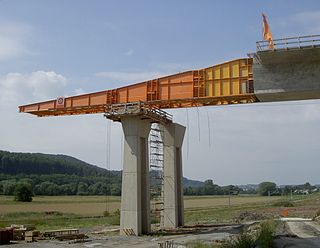
Incremental launch is a method in civil engineering of building a complete bridge deck from one abutment of the bridge only, manufacturing the superstructure of the bridge by sections to the other side. In current applications, the method is highly mechanised and uses pre-stressed concrete.

The Yowaka River bridge is a heritage-listed road bridge that carries the Princes Highway across the Yowaka River at Greigs Flat, New South Wales, Australia. It was built in 1936. The bridge is also known as the Yowaka Bridge near Eden. The bridge is owned by Transport for NSW. It was added to the New South Wales State Heritage Register on 20 June 2000.

The Grandfey-Viaduct is on the railway line from Bern to Fribourg and is one of the largest bridges in Switzerland.

The Long Gully Bridge, also known as Northbridge, Suspension Bridge, and Cammeray Bridge, is a concrete arch road bridge that carries Strathallen Avenue across Flat Rock Creek and Tunks Park, and connects the suburbs of Cammeray, in the North Sydney Council local government area to its south, with Northbridge in the City of Willoughby local government area to its north, in Sydney, New South Wales, Australia.

Tavanasa Bridge, also known as Vorderrheinbrücke, Tavanasa is the name of the two reinforced concrete three hinged arch bridges designed by Swiss civil engineer Robert Maillart. The first of these was constructed in 1904, but later destroyed by an avalanche. The second, constructed in 1928 stands to this day.

The Zuoz Bridge, also known as Innbrücke Zuoz is a three hinged reinforced concrete box girder hinged arch bridge designed by Swiss civil engineer Robert Maillart, and is the first box girder bridge to be constructed out of reinforced concrete. Constructed in 1901, this was the first of his independently designed reinforced concrete arch bridges.





















